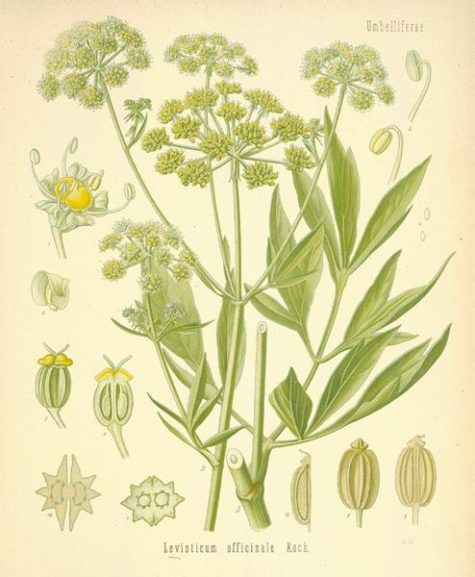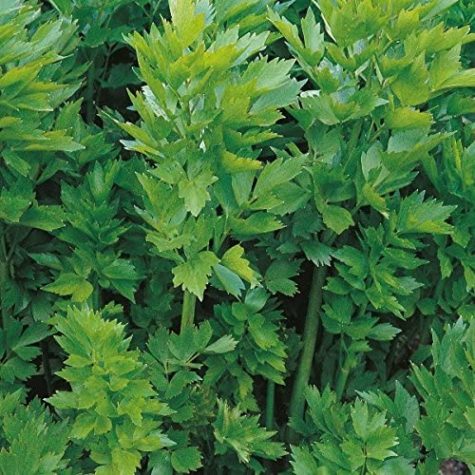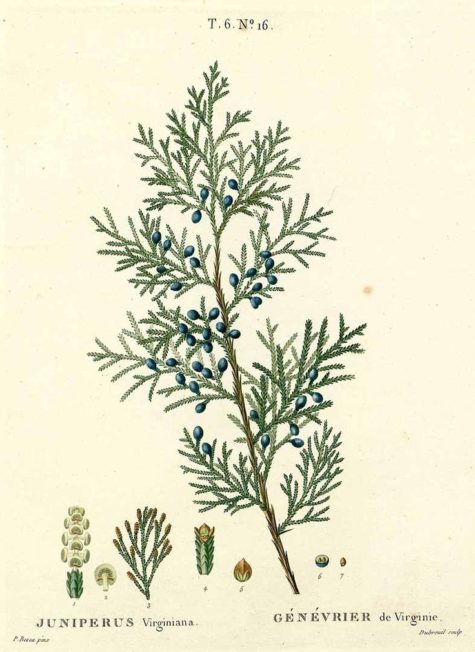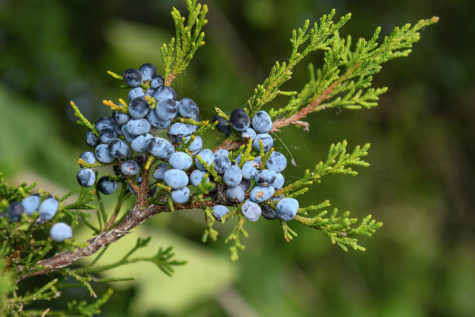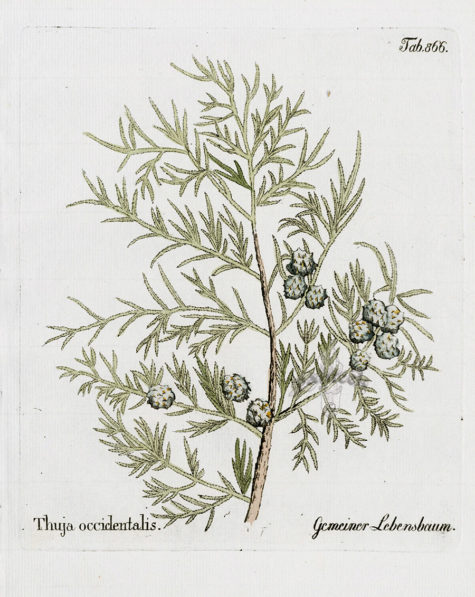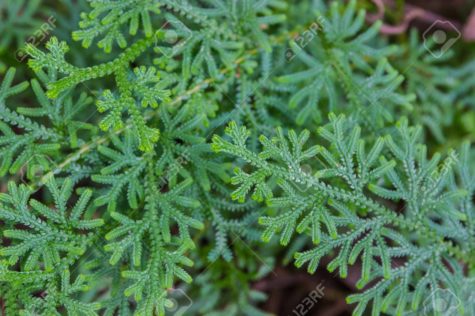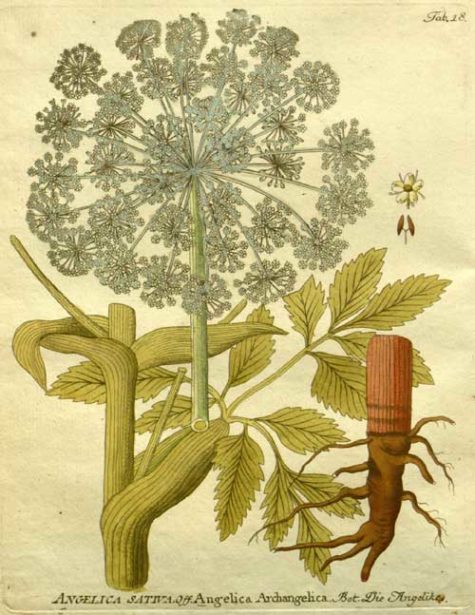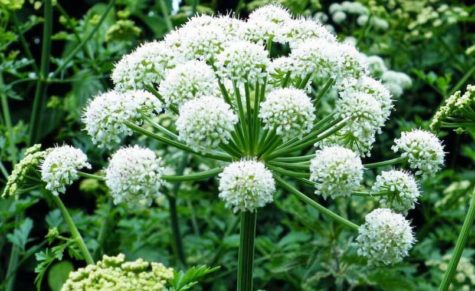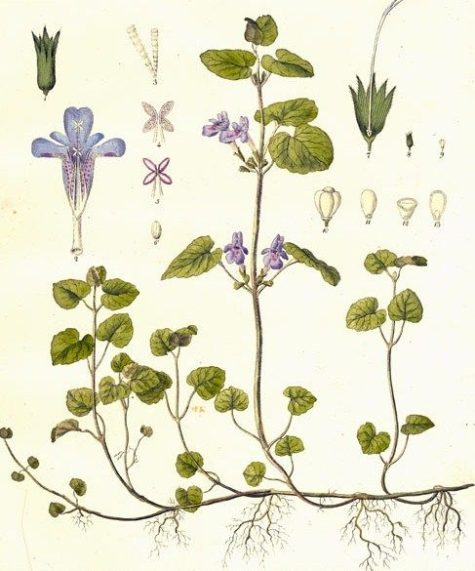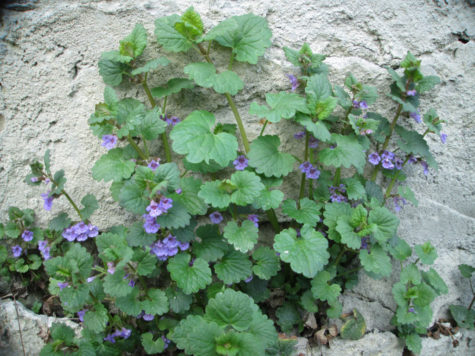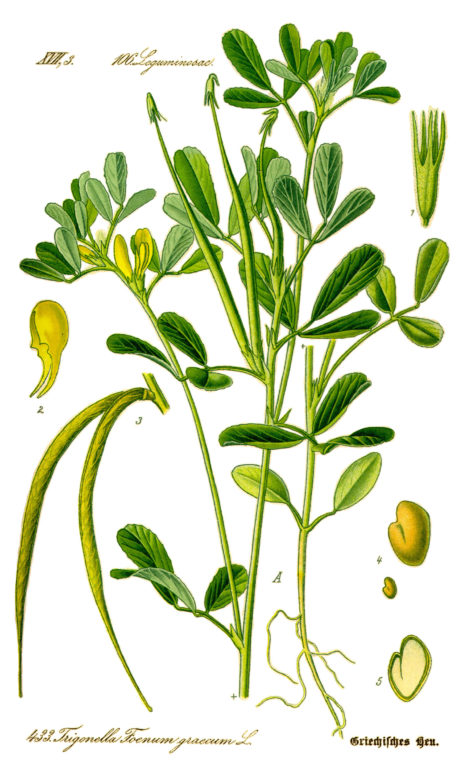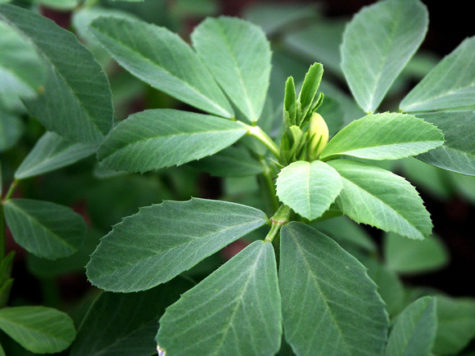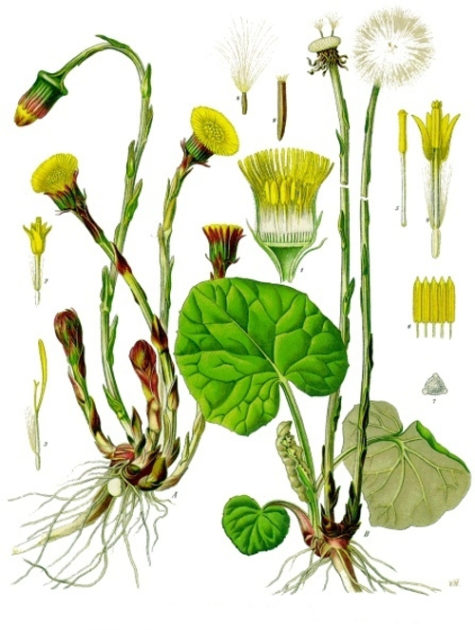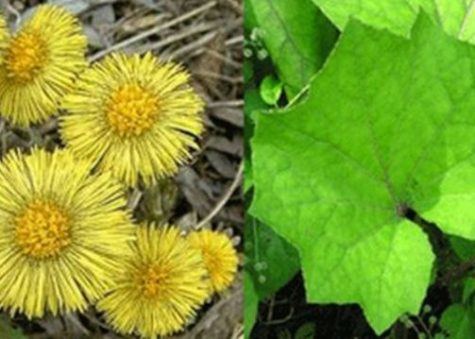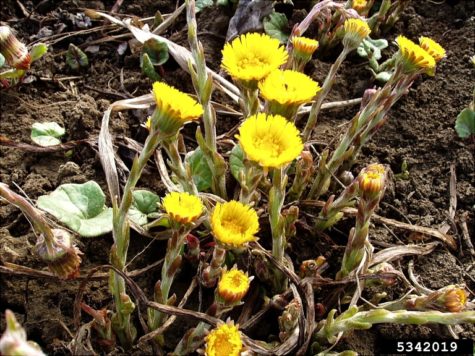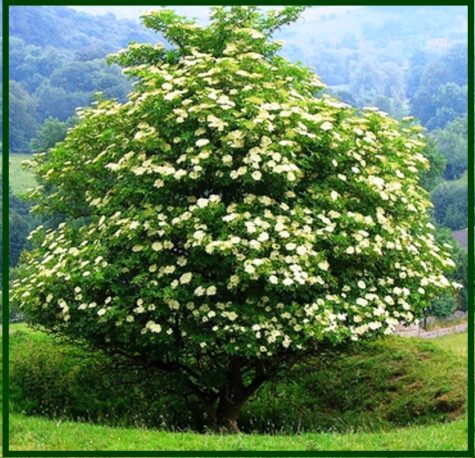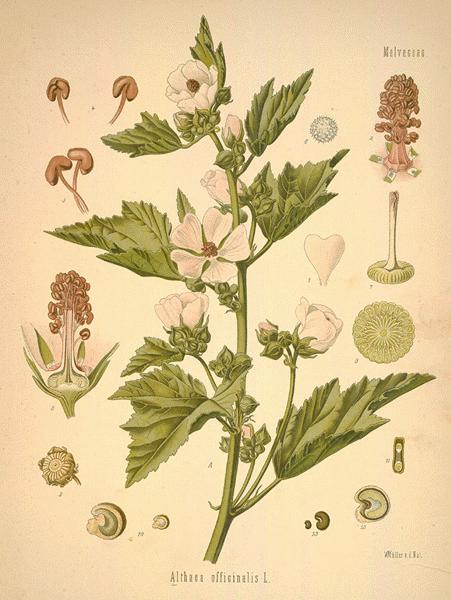Expectorant
Lovage
- Scientific Name: Levisticum officinale
- Plant Family: Umbelliferae
- Parts Used: Root, Leaves
- Actions: Carminative, Diuretic, Emmenagogue, Expectorant, Stimulant, Stomachic.
Cautions:
In excessive doses it can cause kidney damage; and should not be used by those with kidney problems. Lovage promotes the onset of menstruation and should not be used by pregnant women.
The Basics:
An ancient cure for a variety of diseases, Lovage is enjoying a surge of popularity both in the United States and Europe for salads, soups, pies, candies, and for itself.
Medicinally, Lovage is mostly used for its diuretic properties in cases of water retention and urinary difficulties. Lovage is taken by mouth as “irrigation therapy” for pain and swelling (inflammation) of the lower urinary tract, for preventing of kidney stones, and to increase the flow of urine during urinary tract infections.
Lovage has also been used for disorders of the stomach and feverish attacks in case of colic and for flatulence in children. It was also used for gravel, jaundice, and urinary problems.
The whole plant has a strong, aromatic odor, and for this reason, the herb was also added to baths, probably as a deodorant. Skin problems will sometimes respond to a decoction added to bath water.
Lovage has been used in infusions, tinctures, decoctions, vinegars, elixirs, lozenges, and bath and foot soaks. Continue reading
Eastern Red Cedar
- Scientific Name: Juniperus virginiana
- Parts Used: Berries (female cones), branches, leaves, bark
- Actions: Anti-inflammatory, Diaphoretic, Expectorant, Astringent, Antimicrobial, Diuretic, Antiasthmatic, Antifungal
The uses of Eastern Red Cedar branch out into many. They are very similar to the Old World, standard Common Juniper in that its female cones- or berries- are one of its favored usable parts, if not an attribute of the plant that really grabs the eye. When you see the Cedar’s fragrant branches heavily-laden with these bright blue little “fruits,” it’s hard for an herbalist to think that these are NOT somehow useful!
One of the virtues of the berry is that it goes impeccably well with several mediums: salve, tincture, elixir, syrup, you name it. What more: it tastes delicious, and mixes well with a large variety of other herbal flavors in combination, if you are crafting a blend or formula of sorts. The twigs, leaves, branches and bark of Cedar have effects and flavor too, although they are notably more intense and astringent, having a reputation of being hard to extract; their use is important, but not as eclectic.
I would wager that the berries are more for tonic use, whereas the rest of this beautiful plant should be saved for acute situations, which I will get to later. Berries can be picked during the fall or winter, as they last, when they “ripen” to an appetizing-looking blue.
Remember: Cedar trees tend to be dioecious (at least the Eastern Reds are). That is, there are males and females of the species. If it is fall or winter, and the trees you are looking at for harvesting don’t seem to have blue cones, chances are they are male. Keep looking– you will more than likely stumble upon a female tree not far off.
In its many mediums, the berries serve as a very ideal winter medicine– all the better since they can, for the most part, be harvested all winter as the berries are available. They are high in Ascorbic Acid, or Vitamin C, an ideal vitamin to take over the winter for immune support. Even if you don’t have a cold, their use as a tonic will be more than welcome.
When winter illnesses take a nasty turn, Eastern Red Cedar berries work with expectorant action, helping the lungs clear out excess mucus and promote a healthy cough. It can be useful for a dry or wet cough: it relieves that “tickle” you may feel with a scratchy, dry throat with a hoarse cough, but it also stimulates the lungs to cough more productively, and expel phlegm in less time than without it. So here you have a medicine that stimulates the immune system, relieves a scratchy throat, improves your cough– and tastes great!
Cedar berries in syrup form are especially delightful. Sounds like quite a valuable ally to have, if you ask me.
Medicinal Uses
The young leafy twigs of the red cedar were officially listed in the U.S. Pharmacopoeia from 1820 to 1894 as a diuretic. The distilled oil of the red cedar has been officially listed as a reagent in the U.S. Pharmacopoeia since 1916.
The berries in decoction are diaphoretic and emmenagogue, like those of Common Juniper, and the leaves have diuretic properties.
People take Eastern red cedar for cough, bronchitis, joint pain (rheumatism), water retention, and flatulence. They also take it to improve appetite and digestion, and as a treatment for fungal infections and worms.
People apply Eastern red cedar to the skin for wounds, skin rashes, hair loss, eczema, acne, warts, fungal skin infections, and hemorrhoids. They also rub it onto joints for rheumatism, and onto the chest for asthma.
In the Native-Hispanic tradition, Cedars and their relatives are valued highly for the properties of their leaves, “needles,” or branches. These hold the more potent effects of the tree, and as such, are more difficult to capture in preparations. They can be slightly toxic.
The berries are used when there are excess fluids in the body, but Juniper really shines when the kidneys are sluggish, dilating tissues to increase urine flow, and reducing excess mucus production. It’s diuretic actions are truly remarkable, and is indicated in many cases of edema. Those berries are irritating, though, and are not recommended in large doses, for long-term use, and definitely not for those with kidney problems.
Eating 3-5 fresh berries is suggested for an upset stomach. It is thought the bitter nature stimulates gastric juices and improves digestion.
While certainly not widely considered poisonous or dangerous, it is still good to be careful. Be sparing when using preparations of Cedar needles or branches, even the berries, for that matter. Cedars are very powerful diuretics. When taken overboard, they cause kidney irritation, which feels like cramping in the abdomen– similar to a period cramp. Even higher doses can be more dangerous. Folks with weak kidneys, or outstanding kidney issues should avoid using the Cedar leaf.
Thuja aka Arborvitae
- Parts Used: Young twigs
- Constituents: 1% volatile oil including thujone, flavonoid glyoside, musilage, tannin.
- Actions: Expectorant, Stimulant to smooth muscles, Diuretic, Astringent, Alterative, Anthelmintic, Diaphoretic, Emmenagogue
- Cautions: Avoid during pregnancy. Taken in excess the essential oil can produce unpleasant results; it was officially listed as an abortifacient and convulsant in overdose.
Thuja is a genus of coniferous trees in the Cupressaceae (cypress family). There are five species in the genus, two native to North America and three native to eastern Asia.
- White Cedar – Thuja occidentalis
- Western Red Cedar – Thuja plicata
- Korean Thuja – Thuja koraiensis
- Japanese Thuja – Thuja standishii
- Sichuan Thuja – Thuja sutchuenensis
Members are commonly known as arborvitaes, (from Latin for tree of life) Thujas or Cedars. The name Thuja is a latinized form of a Greek word meaning ‘to fumigate,’ or thuo (‘to sacrifice’), for the fragrant wood was burnt by the ancients with sacrifices. The tree was described as ‘arbor vita ‘ by Clusius, who saw it in the royal garden of Fontainebleau after its importation from Canada.
The Basics
Most of the herbal information I found on Thuja refers specifically to Thuja occidentalis – White Cedar, or Arborvitae – but it is possible that the other varieties share similar characteristics and qualities.
- It is important not to confuse the Western Red Cedar (Thuja plicata) with the Eastern Red Cedar (Juniperus virginiana) as the two are quite different.
The name arborvitae is particularly used in the horticultural trade in the United States. It is Latin for “tree of life” – due to the medicinal properties of the sap, bark, and twigs. Despite its common names, it is not a true cedar in the genus Cedrus, nor is it related to the Australian white cedar, Melia azedarach.
Thuja is used for respiratory tract infections such as bronchitis, bacterial skin infections, and cold sores. It is also used for painful conditions including osteoarthritis and a nerve disorder that affects the face called trigeminal neuralgia.
Some people use Thuja to loosen phlegm (as an expectorant), to boost the immune system (as an immunostimulant), and to increase urine flow (as a diuretic). It has also been used to cause abortions.
Thuja is sometimes applied directly to the skin for joint pain, ostearthritis, and muscle pain. Thuja oil is also used for skin diseases, warts, and cancer; and as an insect repellent.
In foods and beverages, Thuja is used as a flavoring agent. In manufacturing, Thuja is used as a fragrance in cosmetics and soaps.
According to WebMD, Thuja contains chemicals that might fight viruses. It also contains a chemical called thujone that can cause brain problems.
Angelica
- Scientific Name: Angelica archangelica
- Plant Family: Umbelliferae
- Parts Used: Root, seed, stems
- Actions: Alterative, Antimicrobial, Aromatic, Bitter, Carminative, Circulatory Stimulant, Diaphoretic, Diffusive, Emmenagogue, Expectorant, Grounding, Nervine
Notes: Angelica archangelica is not the same plant as Chinese Angelica (A. sinesis), often referred to as dong quai or dang gui. There are about 30 varieties of Angelica, but Angelica archangelica is the only one officially employed in medicine.
Cautions: Use care when wildcrafting, as it resembles both Queen Anne’s Lace (a benign wild carrot) and Water Hemlock (a poisonous plant).
The Basics:
Angelica is a stunning white flower that looks like a white starburst exploding across the green hillsides. One of Iceland’s most cherished herbs, it is not only beautiful, but also appreciated as a nutritious food, a liqueur and an herbal remedy. The roots and stems can be boiled or pickled and are considered a delicacy in all of Scandinavia. The stems were used to make a musical flute, as well as flavor reindeer milk or be crystallized in sugar for desserts.
Angelica is a veritable giant in the herb world. The towering plant is widely traveled and has a background rich in herbal lore. Use has been made of leaves, stems, roots, and seeds in cooking and in medicine.
Angelica is used for heartburn (dyspepsia), intestinal gas (flatulence), loss of appetite (anorexia), overnight urination (nocturia), arthritis, stroke, dementia, circulation problems, “runny nose” (respiratory catarrh), nervousness and anxiety, fever, plague, and trouble sleeping (insomnia).
According to WebMD, Angelica contains chemicals that might kill cancer cells and fungus, reduce anxiety, and settle the stomach.
Some women use Angelica to start their menstrual periods. Sometimes this is done in hopes of causing an abortion. Angelica is also used to increase urine production, improve sex drive, stimulate the production and secretion of phlegm, and kill germs.
Some people apply Angelica directly to the skin for nerve pain (neuralgia), joint pain (rheumatism), and skin disorders. In combination with other herbs, Angelica is also applied to the skin for treating premature ejaculation.
Angelica is also used as a smell in aromatherapy to reduce symptoms associated with quitting tobacco (nicotine withdrawal).
It should be noted that Angelica has a tendency to increase the sugar in the urine, so those with a tendency to diabetes should avoid it.
A strong volatile oil is present in all parts of the plant, but especially in the root, and Angelica is effective as a general tonic. Eating Angelica stalks is said to relieve flatulence and soothe “a feeble stomach.”
Drinking Angelica tea is said to promote urine and perspiration. It is also reputed to cause a strong dislike for alcohol and is sometimes used as a treatment for alcoholics.
Strain the tea to make a cool bath for tired eyes or a wash to cleanse the skin. The scented leaves are an ingredient in potpourri. Bees and wasps are attracted by the abundant nectar on Angelica flowers.
Continue reading
Ground Ivy
- Scientific Name: Glechoma hederacea
- Plant Family: Lamiaceae
- Parts Used: Leaves, stems, and flowers
- Actions: Expectorant, Astringent, Diuretic, Tonic, a gentle Stimulant, Anti-catarrhal, Vulnerary
General Overview:
Ground Ivy is an aromatic, perennial, evergreen creeper of the mint family. This little plant grows on waste ground and in hedgerows everywhere, the leaves are dark and kidney shaped and the flowers bright dark blue. The Romanies made a tea from Ground Ivy flowers and wood sage as a cure for fevers and colds. The herb is used by herbalists in the treatment of blood and kidney disorders.
The leaves are downy, dark green and kidney-shaped, with glands that contain an aromatic, bitter oil. The tiny deep-throated flowers are purple or blue.
Some people consider Ground Ivy to be an attractive garden plant, and it is grown in pots and occasionally as a groundcover. Easily cultivated, it grows well in shaded places. A variegated variety is commercially available; in many areas this is the dominant form which has escaped cultivation and become established as an aggressive, adventitious groundcover.
Note:
Ground Ivy is sometimes confused with common mallow (Malva neglecta), which also has round, lobed leaves; but mallow leaves are attached to the stem at the back of a rounded leaf, where Ground Ivy has square stems and leaves which are attached in the center of the leaf, more prominent rounded lobes on their edges, attach to the stems in an opposite arrangement, and have a hairy upper surface.
In addition, mallow and other creeping plants sometimes confused with Ground Ivy do not spread from nodes on stems. In addition, Ground Ivy emits a distinctive odor when damaged, being a member of the mint family.
The Basics:
Ground Ivy has been used in the traditional medicine of Europe going back thousands of years: Galen recommends the plant to treat inflammation of the eyes. John Gerard, an English herbalist, recommended it to treat tinnitus, as well as a “diuretic, astringent, tonic and gentle stimulant. Useful in kidney diseases and for indigestion.” It has also been used as a “lung herb.”
Its presence as an invasive weed in North America is the result of the value placed on it by European settlers as a medicinal herb and ale preservative; the species was imported and widely cultivated in herb and kitchen gardens.
Other traditional uses include as an expectorant, astringent, and to treat bronchitis. In the traditional Austrian medicine the herb has been prescribed for internal application as salad or tea for the treatment of a variety of different conditions including disorders associated with the liver and bile, gastrointestinal tract, respiratory tract, kidneys and urinary tract, fever, and flu.
An ancient ale herb, bitter Ground Ivy was used to clear and flavor ale before the introduction of hops.
Continue reading
Fenugreek
- Scientific Name: Trigonella foenum-graecum
- Plant Family: Leguminosae
- Parts Used: Seeds
- Medical Actions: Expectorant, Demulcent, Tonic, Galactagogue, Emmenagogue, Emollient, Vulnerary
- Constituents: 30% mucilage, bitter principle, volatile and fixed oil, flavonoids, alkaloids, coumarins, vitamins, and saponins; the most prevalent alkaloid is trigonelline and coumarins include cinnamic acid and scopoletin.
The Basics
Originally from the eastern Mediterranean, cultivated in Europe, Africa and Asia for thousands of years as a fodder plant, a medicine, and a spice, Fenugreek is an herb that has an ancient history. It has great use in local healing and reducing inflammation for conditions such as wounds, boils, sores, fistulas, and tumors.
It can be taken to help bronchitis and gargled to ease sore throats. It’s bitterness explains its role in soothing disturbed digestion.
The seeds are rich in vitamins, nitrates and calcium, have a softening soothing action and are said to encourage lactation. It is a strong stimulator of milk production in nursing mothers, for which it is perfectly safe, and also has a reputation for stimulating development of the breasts.
In traditional medicine, Fenugreek is thought to promote digestion, induce labour, and reduce blood sugar levels in diabetics.
Description
It is an annual and grows about 2 ft high with yellowish peaflowers in midsummer, trifoliate leaves and long narrow pods containing at least 10 square seeds, reaching maturity in a few months in warm climates. It is tender in temperate climates.
It is an annual, erect, robust aromatic herb which grows up to a height of 60 cm. it has compound leaves around 5 cm in length, with long pedicles. The leaflets are obovate, around 2.5 cm long and the margins are slightly toothed. Flowers are seen in pairs or single, axillary and yellow in color. Fruits of the plant are leguminous pods around 5-8 cm long, with a persistent beak, narrow and enclose 10-20 golden yellow seeds which have a typical savory aroma.
Cultivation and Harvesting
Fenugreek is a fairly fragile annual that has a visual similarity to clover. Preferring rich soils and requiring full sun, it grows from one to two feet in height and blooms in smallish white flowers during midsummer.
The primary caution in planting Fenugreek is an awareness of soil temperature. It must have a soil temperature of at least 55°F to germinate, in colder or very damp soils the seeds will rot, and the plant itself will be prone to root rot even when older.
Harvest the seeds when the pods are ripe, but just before they open. Remove the seeds from the pods and dry them naturally in the sun
Medicinal Uses
Fenugreek is a herb which is bitter to taste and increases lactation, soothes tissues which are irritated, stimulates uterus, reduces fever, blood sugar, improves digestion, improves relieving capacity and works as an expectorant, diuretic, laxative, anti-tumour and anti-parasitic effects. Fenugreek relieves diabetes, poor digestion, tuberculosis, gastric inflammation and digestive disorders.
Fenugreek acts as a reliever for many ailments, here is a quick list:
- Cholesterol: It is a proven fact that by consuming Fenugreek cholesterol can be balanced. Around 2 ounces can be taken every day.
- Diabetes: Fenugreek is effective in relieving Type 2 diabetes. Consumption of around 500 mg Fenugreek every day will yield the desired results.
- Skin inflammation: Fenugreek is very effective in relieving burns, boils, abscesses, gout and eczema. Fenugreek powder should be made into a paste with water and a cloth should be soaked into this paste. The soaked cloth can be applied on the affected area of the skin as a poultice.
- Heartburn and Acid Reflux: Seeds of Fenugreek contain mucilage which help is soothing gastrointestinal inflammation. It coats the lining of the intestine and stomach. Hence it works effectively against acid reflux and heartburn. Around 1 teaspoon Fenugreek seeds can be swallowed along with water before meal.
- Fever: This herb is useful for reducing fever. The seeds should be consumed along with honey and lemon.
- Breast enlargement: Fenugreek balances female hormones. It should be consumed up to 3g every day.
- Child Birth problems: Fenugreek stimulates uterine contractions and is helpful in inducing childbirth. But pregnant women should use this remedy only after consulting the doctor.
- Lactation: Fenugreek influences milk production in nursing mothers.
Coltsfoot
- Scientific name: Tussilago Farfara
- Family: in the groundsel tribe of the daisy family Asteraceae
- Recommended variety: Tussilago farfara ‘Wien’
- Parts Used: Leaves, flowers, root.
- Medicinal Actions: Demulcent, expectorant, tonic, antitussive, anticatarrhal, diuretic, emollient, pectoral.
- Constituents: All parts of the plant abound in mucilage, and contain inulin, zinc, a little tannin and a trace of a bitter amorphous glucoside. The flowers contain also a phytosterol and a dihydride alcohol, Faradial, and carotene
Cautions:
Coltsfoot root contains tumorigenic pyrrolizidine alkaloids and it suspected that there may be small quantities in the leaves. There are documented cases of coltsfoot tea causing severe liver problems in an infant, and in another case, an infant developed liver disease and died because the mother drank tea containing coltsfoot during her pregnancy. In response the German government banned the sale of coltsfoot. Clonal plants of colstfoot free of pyrrolizidine alkaloids were then developed in Austria and Germany. This has resulted in the development of the registered variety Tussilago farfara ‘Wien’ which has no detectable levels of these alkaloids.
The Basics:
The coltsfoot is another wonderful remedy for coughs and colds, whooping cough and shortness of breath. It has a little yellow flower that smells of honey and blooms in February, long before the leaves which grow to enormous size.
Coltsfoot grows nearly everywhere, on rubble heaps, by the side of newly-made roads, on railway banks and on coal mine tips. In fact there is a very old gypsy saying that wherever coltsfoot grows freely, coal will be found. Once it was so revered in France that coltsfoot flowers were painted as a sign on the doorpost of apothecarie’s shops to let people know that the art of healing was practiced there.
Coltsfoot combines a soothing expectorant effect with an antispasmodic action. There are useful levels of zinc in the leaves. This mineral has been shown to have marked anti-inflammatory effects. Coltsfoot may be used in chronic or acute bronchitis, irritating coughs, whooping coughs and asthma. Its soothing expectorant action gives coltsfoot a role in most respiratory conditions, including the chronic state of emphysema.
The Romanies praise this herb very highly. It also has been a part of Chinese folk medicine for centuries.
A decoction of the leaves of the herb coltsfoot to a pint of boiling water (strain before drinking) is very good for colds, coughs and asthma. If you haven`t time to make a decoction when a cough is bad, use an infusion of coltsfoot and take in teacupful dose. It can be sweetened to taste with honey.
As a mild diuretic it has been used in cystitis.
An infusion or juice from fresh leaves can be used as an antiseptic wash for wounds and skin blemishes. The fresh bruised leaves can be applied to boils, abscesses and suppurating ulcers as a poultice, (enclosed in fine muslin to prevent skin irritation)..
Description
Coltsfoot is a low-growing perennial with fleshy, woolly leaves. A member of the daisy family, coltsfoot produces a single golden-yellow flower head that blooms in spring. As the stem dies, the leaves appear. It has long-stalked, hoof-shaped leaves, about 4 inches across, with angular teeth on the margins. The top of the leaf surface is smooth and almost waxy in appearance, while the underside is covered with white, wool-like hairs. Both surfaces of the leaves are covered, when young, with loose, white, felted woolly hairs, but those on the upper surface fall off as the leaf expands.
The bright yellow flowers appear early in the spring, prior to the emergence of any leaves. In Southern Ontario, coltsfoot flowers in April, often before the last of the snow melts. Flower heads have even been known to push through snow. Some people confuse these flowers with dandelion flowers.
The specific name of the plant is derived from Farfarus, an ancient name of the White Poplar, the leaves of which present some resemblance in form and color to those of this plant. There is a closer resemblance, however, to the leaves of the Butterbur, which must not be collected in error; they may be distinguished by their more rounded outline, larger size and less sinuate margin.
An old name for Coltsfoot was Filius ante patrem (the son before the father), because the star-like, golden flowers appear and wither before the broad, sea-green leaves are produced.
The root is spreading, small and white, and has also been used medicinally. The underground stems preserve their vitality for a long period when buried deeply, so that in places where the plant has not been observed before, it will often spring up in profusion after the ground has been disturbed. In gardens and pastures it is a troublesome weed, very difficult to get rid of.
The plant is so dissimilar in appearance at different periods that both Gerard and Parkinson give two illustrations: one entitled ‘Tussilago florens, Coltsfoot in floure,‘ and the other ‘Tussilago herba sine flore.’
‘Coltsfoot hath many white and long creeping roots, from which rise up naked stalkes about a spanne long, bearing at the top yellow floures; when the stalke and seede is perished there appeare springing out of the earth many broad leaves, green above, and next the ground of a white, hoarie, or grayish colour. Seldom, or never, shall you find leaves and floures at once, but the floures are past before the leaves come out of the ground, as may appear by the first picture, which setteth forth the naked stalkes and floures, and by the second, which porttraiteth the leaves only.’
Pliny and many of the older botanists thought that the Coltsfoot was without leaves, an error that is scarcely excusable, for, notwithstanding the fact that the flowers appear in a general way before the leaves, small leaves often begin to make their appearance before the flowering season is over.
Habitat and Cultivation
Coltsfoot, for all its beauty, tends to like rough places to hang out. Seek it in waste ground, building sites, roadsides, the edge of woods, remembering that it has a preference for heavy clay.
Coltsfoot grows abundantly throughout England, especially along the sides of railway banks and in waste places, on poor stiff soils, growing as well in wet ground as in dry situations. The plant is native to Europe, but also grows widely throughout the United States and Canada.
Coltsfoot is found in open, disturbed areas. It often grows in ditches, along roadsides, on forest edges and on steep slopes prone to landslides. It tolerates wet, poorly drained areas and riverbanks susceptible to spring flooding.
Coltsfoot is collected widely from wild plants in the Balkans, Eastern Europe (Bulgaria, Czechoslovakia, Hungary, Poland, the former Yugoslavia), and Italy.
Collection
After the leaves have died down, the shoot rests and produces in the following February a flowering stem, consisting of a single peduncle with numerous reddish bracts and whitish hairs and a terminal, composite yellow flower, whilst other shoots develop leaves, which appear only much later, after the flower stems in their turn have died down.
These two parts of the plant, both of which are used medicinally, are, therefore, collected separately and usually sold separately.
The flowers should be gathered before they have fully bloomed (end of late winter to mid-spring) and dried carefully in the shade. The leaves are best collected between late spring and early summer. They should be chopped up before they are dried and stored. The fresh leaves can be used until Fall.
Medicinal Uses
Demulcent, expectorant and tonic. One of the most popular of cough remedies. The botanical name, Tussilago, signifies ‘cough dispeller,’ and Coltsfoot has justly been termed ‘nature’s best herb for the lungs and her most eminent thoracic.’
As part of its Latin name Tussilago implies, coltsfoot is reputed as an antitussive. The buds, flowers, and leaves of coltsfoot have been long used in traditional medicine for dry cough and throat irritation. The plant has found particular use in Chinese herbal medicine for the treatment of respiratory diseases, including cough, asthma, and acute and chronic bronchitis. Continue reading
Elder Tree
- Scientific Name: Sambucus Nigra
- Plant Family: Caprifoliaceae
- Parts Used: Bark, Flowers, Berries, Leaves
- Actions: Vary based on what part of the plant is used
- Bark: Purgative, emetic, diuretic
- Leaves: Externally emollient and vulnerary, Internally as purgative, expectorant, diuretic and diaphoretic
- Flowers: Diaphoretic, anti-catarrhal, pectoral
- Berries: Diaphoretic, diuretic, laxative
Varieties:
The elder tree grows in Britain and from Scandinavia to the coast of Africa, a twisted, shrubby tree, seldom more than 30 ft high and common in hedgerows and waste places. The strong smelling leaves are divided into broad leaflets, creamy flowers grow in sweetly scented clusters in midsummer and in the late summer black juicy berries ripen and fall.
Note: Do not confuse European Elder (Sambucus Nigra) with American Elder, Elderflower, or Dwarf Elder. There are other, similar elder species in Europe and North America but these have different properties. For a definitive list of the various elder species, and to verify that you are using Sambucus nigra (European or Black Elder) visit this link via wikipedia: Sambucus
The Basics:
Elder has a very long history of household use as a medicinal herb and is also much used by herbalists. The plant has been called “the medicine chest of country people.”
The bark and leaves of the elder have a violent purgative action when taken internally and are not safe. However, used externally, the juice of the leaves is cooling, soothing and healing and thus has been a common and efficient domestic remedy for several thousand years.
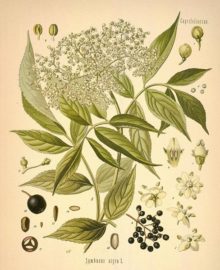 The inner bark is collected from young trees in the autumn and is best sun-dried. It is diuretic, a strong purgative and in large doses emetic. It is used in the treatment of constipation and arthritic conditions. An emollient ointment is made from the green inner bark. The pith of young stems is used in treating burns and scalds. A homeopathic remedy is made from the fresh inner bark of young branches. It relieves asthmatic symptoms and spurious croup in children.
The inner bark is collected from young trees in the autumn and is best sun-dried. It is diuretic, a strong purgative and in large doses emetic. It is used in the treatment of constipation and arthritic conditions. An emollient ointment is made from the green inner bark. The pith of young stems is used in treating burns and scalds. A homeopathic remedy is made from the fresh inner bark of young branches. It relieves asthmatic symptoms and spurious croup in children.
The leaves are used primarily for bruises, sprains, wounds and chilblains. The leaves can be used both fresh or dry. The leaves are purgative, but are more nauseous than the bark. They are also diaphoretic, diuretic, expectorant and haemostatic. The juice is said to be a good treatment for inflamed eyes. An ointment made from the leaves is emollient and is used in the treatment of bruises, sprains, chilblains, wounds etc. It has been reported that Elder Leaves may be useful in an ointment for tumors.
The flowers are the main part used in modern herbalism, Elder flowers are ideal for the treatment of colds and influenza. They are indicated in any catarrhal inflammation of the upper respiratory tract such as hay fever and sinusitis. Catarrhal deafness responds well to Elder Flowers. The fresh flowers are used in the distillation of “Elder Flower Water”. The flowers can be preserved with salt to make them available for distillation later in the season. The water is mildly astringent and a gentle stimulant. It is mainly used as a vehicle for eye and skin lotions.
The dried flowers are diaphoretic, diuretic, expectorant, galactogogue and pectoral. An infusion is very effective in the treatment of chest complaints and is also used to bathe inflamed eyes. The infusion is also a very good spring tonic and blood cleanser. Externally, the flowers are used in poultices to ease pain and abate inflammation. Used as an ointment, it treats chilblains, burns, wounds, scalds etc.
Elder Berries have similar properties to the Flowers, with the addition of their usefulness in rheumatism. The fruit is depurative, weakly diaphoretic and gently laxative. A tea made from the dried berries is said to be a good remedy for colic and diarrhoea. The fruit is widely used for making wines, preserves etc., and these are said to retain the medicinal properties of the fruit.
The root is no longer used in herbal medicine but it formerly had a high reputation as an emetic and purgative that was very effective against dropsy.
Are Elderberries poisonous?
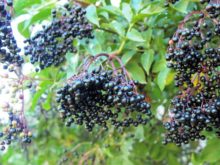 Most species of Sambucus berries are edible when picked ripe and then cooked. Both the skin and pulp can be eaten. However, it is important to note that most uncooked berries and other parts of plants from this genus are poisonous. Sambucus nigra is the variety of Elderberry that is most often used for health benefits as it is the only variety considered to be non-toxic even when not cooked, but it is still recommended to cook the berries at least a little to enhance their taste and digestibility. Continue reading
Most species of Sambucus berries are edible when picked ripe and then cooked. Both the skin and pulp can be eaten. However, it is important to note that most uncooked berries and other parts of plants from this genus are poisonous. Sambucus nigra is the variety of Elderberry that is most often used for health benefits as it is the only variety considered to be non-toxic even when not cooked, but it is still recommended to cook the berries at least a little to enhance their taste and digestibility. Continue reading
Marsh Mallow
- Scientific Name: Althaea officinalis
- Plant Family: Malvaceae
- Parts Used: The whole plant – Leaves, root, flowers.
- Actions (root): Demulcent, Diuretic, Emollient, Vulnerary
- Actions (leaf): Demulcent, Expectorant, Diuretic, Emollient, Anti-Catarrhal, Pectoral
The Basics:
All mallows, including the garden hollyhock, contain quantities of mucilage and the marsh mallow is an especially soothing, healing herb, useful in treating bronchitis, internal inflammation and irritation, for stimulating the kidneys and as a gentle laxative. Tea made from the leaves makes a soothing eye bath.
The high mucilage content of Marsh Mallow makes it an excellent demulcent (relieves inflammation). The root is used primarily for digestive problems, inflammations of the digestive tract and on the skin. The leaf is used for the lungs and the urinary system. For bronchitis, respiratory catarrh and irritating coughs consider Marsh Mallow leaf. It is very soothing in urethritis and urinary gravel. Externally, the root is indicated in varicose veins and ulcers as well as abscesses and boils.
There are many species of mallow growing around the world, often used as food or medicine and possessing similar properties. The young leaves of all the European mallows can be eaten in salads, the older leaves in soups, the roots boiled or fried and the seeds, known as cheeses, chewed fresh. They are all wholesome and their flavor faint and delicate. Continue reading
Rennie Luttrull: queen-annes-lace-seeds
Rosanna: Spignel aka Bald Money
Annamarie Squatrito: Fumitory
EILEEN Klinghagen: Pumpkin
Mahmudul Hasan: Celery
